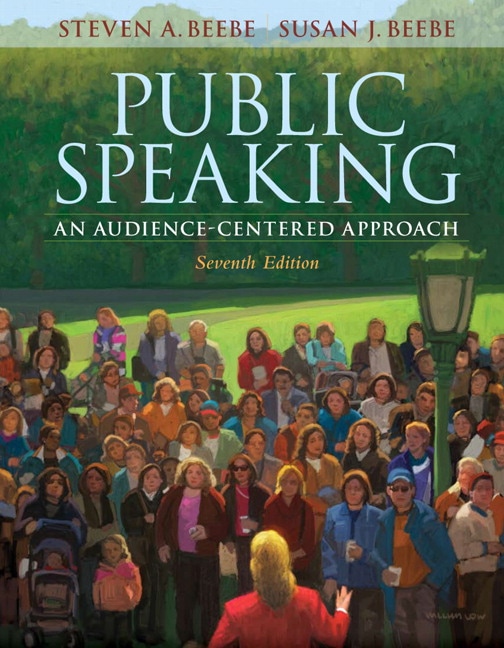
30.00$
Table of Contents
Each chapter concludes with “Summary,” “Being Audience-Centered: A Sharper Focus,” “Critical Thinking Questions,” “Ethical Questions,” and “Speech Workshop.”
1. Speaking with Confidence.
Why Study Public Speaking?
Public Speaking and Conversation.
The Communication Process.
The Rich Heritage of Public Speaking.
Public Speaking and Diversity.
Improving Your Confidence as a Speaker.
2. Previewing the Audience-Centered Speechmaking Process.
The Audience-Centered Speechmaking Model.
Consider Your Audience.
Select and Narrow Your Topic.
Determine Your Purpose.
Develop Your Central Idea.
Generate the Main Ideas.
Gather Verbal and Visual Supporting Material.
Organize Your Speech.
Rehearse Your Speech.
Deliver Your Speech.
3. Speaking Ethically and Freely.
Speaking Freely.
Speaking Ethically.
Listening Ethically.
4. Listening to Speeches.
Barriers to Effective Listening.
Becoming a Better Listener.
Improving Your Note-Taking Skills.
Listening and Critical Thinking.
Analyzing and Evaluating Speeches.
5. Analyzing Your Audience
Becoming an Audience-Centered Speaker.
Analyzing Your Audience Before You Speak.
Adapting to Your Audience as You Speak.
Analyzing Your Audience After You Speak.
6. Developing Your Speech.
Select and Narrow Your Topic.
Determine Your Purpose.
Develop Your Central Idea.
Generate and Preview Your Main Ideas.
Meanwhile, Back at the Computer . . .
7. Gathering Supporting Material.
Personal Knowledge and Experience.
The Internet.
Library Resources.
Interviews.
Resources from Special-Interest Groups and Organizations.
Research Strategies.
8. Integrating Supporting Material.
Illustrations.
Descriptions and Explanations.
Definitions.
Analogies.
Statistics.
Opinions.
Selecting the Best Supporting Material.
9. Organizing Your Speech.
Organizing Your Main Ideas.
Subdividing Your Main Ideas.
Integrating Your Supporting Material.
Organizing Your Supporting Material.
Developing Signposts.
Supplementing Signposts with Presentation Aids.
10. Introducing and Concluding Your Speech.
Purposes of Introductions.
Effective Introductions.
Purposes of Conclusions.
Effective Conclusions.
11. Outlining and Editing Your Speech.
Developing Your Preparation Outline.
Editing Your Speech.
Developing Your Delivery Outline and Speaking Notes.
12. Using Words Well: Speaker Language and Style.
Oral Versus Written Language Style.
Using Words Effectively.
Adapting Your Language Style to Diverse Listeners.
Crafting Memorable Word Structures.
Tips for Using Language Effectively.
13. Delivering Your Speech.
The Power of Speech Delivery.
Methods of Delivery.
Characteristics of Effective Delivery.
Audience Diversity and Delivery.
Rehearsing Your Speech: Some Final Tips.
Delivering Your Speech.
Adapting Your Speech Delivery for Television.
Responding to Questions.
14. Using Presentation Aids.
The Value of Presentation Aids.
Types of Presentation Aids.
Guidelines for Developing Presentation Aids.
Guidelines for Using Presentation Aids.
15. Speaking to Inform.
Goals of Informative Speaking.
Types of Informative Speeches.
Strategies to Enhance Audience Understanding.
Strategies to Enhance Audience Interest.
Strategies to Enhance Audience Recall.
16. Understanding Principles of Persuasion.
Persuasion Defined.
How to Motivate Listeners.
How Persuasion Works.
How to Develop Your Persuasive Speech.
Putting Persuasive Principles into Practice.
17. Using Persuasive Strategies.
Establishing Credibility.
Enhancing Your Credibility.
Using Logic and Evidence to Persuade.
Using Emotion to Persuade.
Strategies for Adapting Ideas to People and People to Ideas.
Strategies for Organizing Persuasive Messages.
18. Speaking on Special Occasions.
Public Speaking in the Workplace.
Ceremonial Speaking.
After-Dinner Speaking: Using Humor Effectively.
Epilogue.
Appendix A: Speaking in Small Groups
Appendix B: The Classical Tradition of Rhetoric.
Appendix C: Speeches for Analysis and Discussion.
I Have a Dream, Martin Luther King, Jr.
Tissue Trade Reform, Christina Costanzo.
Van Gogh’s Incredible Life, Kristy Shaw.
Harvard Commencement Remarks, Bill Gates
Ovarian Cancer: Breaking the Silence, Vigar Mohammed.
The Hillbilly Girl, Bridget Traut.
A Jury Not of Her Peers, Colston Reid.
Notes.
Index.
***THIS IS NOT THE ACTUAL BOOK. YOU ARE BUYING the Test Bank in e-version of the following book***
Public Speaking: An Audience-Centered Approach, 7th Edition PDF Manual Solutions , PDF Public Speaking: An Audience-Centered Approach, 7th Edition , Fast Download Public Speaking: An Audience-Centered Approach, 7th Edition , Steven A. Beebe, Texas State University - San Marcos Susan J. Beebe, Texas State University - San Marcos,Category : Higher Education

0 commentaires:
Enregistrer un commentaire